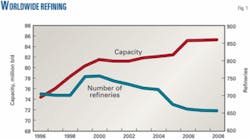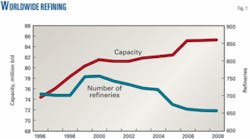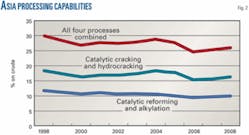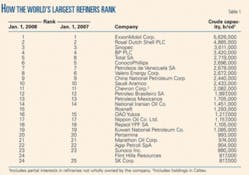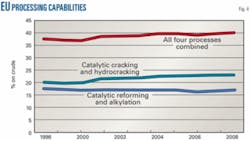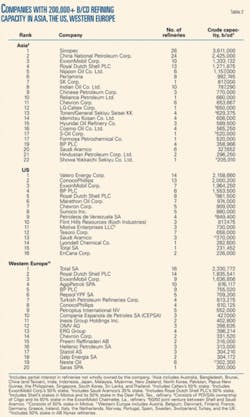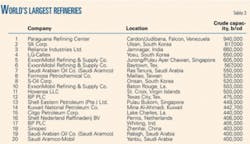Worldwide in 2007, the number of refineries remained stable, while global capacity increased slightly. For the sixth year in a row, worldwide capacity is at a record level.
Last year’s refining report showed a worldwide capacity of 85.179 million b/cd in 658 refineries as of Jan. 1, 2007. This year, OGJ’s survey reflects a total capacity of 85.309 million b/cd in 657 refineries, an increase of slightly more than 129,000 b/cd.
The increase is more than double last year’s gain of 52,000 b/cd.
Fig. 1 shows the trend in operable refineries and worldwide capacity. The large jump in number of refineries in 1999 was due to improved information from China.
Expansions and capacity creep that offset losses were the main reasons for the increases in capacity for the latest survey.
North America showed the largest increase in the amount of refining capacity, up about 103,000 b/cd or 0.5%. Africa showed the largest percentage increase, about 2%, increasing to 3.278 million b/cd from 3.212 million b/cd.
Eastern Europe showed an increase of about 71,000 b/cd.
Other regions experienced decreases in capacity. Asia-Pacific and Western Europe lost capacity according to the latest survey numbers, decreasing about 96,000 b/cd and 13,000 b/cd, respectively.
The Middle East and South America were essentially unchanged, losing 1,900 b/cd and gaining 200 b/cd of capacity, respectively.
New crude capacity
This year’s survey does not list any new refineries. All the increases in refining capacity occurred in existing facilities.
The largest single-facility increase occurred in Rosneft’s Syzran, Russia, refinery. The company reported a capacity of 214,000 b/cd, up from 151,460 b/cd, which was the capacity listed in last year’s survey. The refinery was previously owned by OAO Yukos and was acquired by Rosneft in May 2007 in an auction.
In the US, the largest reported capacity increase occurred in Flint Hills Resources’ Rosemount, Minn., refinery. Flint Hills reported a 43,700-b/cd increase, growing to 323,000 b/cd in this year’s survey from 279,300 b/cd reported in last year’s survey.
Other major increases in reported capacity occurred in BP PLC’s Texas City refinery, which increased to 475,000 b/cd from 446,500 b/cd; Petro-Canada’s Montreal refinery, which rose to 129,800 b/cd from 105,000 b/cd; and Holly Corp.’s Artesia, NM, refinery, which went from 60,000 b/cd to 85,000 b/cd.
Refinery closures, delistings
No refineries shut down in 2007, mainly due to high refining margins that made even the smallest plants profitable.
The only closure reported in this year’s survey is Petro-Canada’s 83,000 b/cd Oakville, Ont., refinery. The company reported that the plant had ceased operations in 2003, but the shutdown was not reflected in the survey until this year.
Other refineries lost capacity as owners restated and updated the survey numbers. Royal Dutch Shell PLC restated capacity for many of its refineries.
Some of the larger declines occurred in Pilipinas Shell Petroleum Corp.’s Tabango, Phillipines, refinery, which lost 51,000 b/cd of capacity, falling to 102,000 b/cd from 153,000 b/cd. The Shell Refining Co. Bhd. Port Dickson, Malaysia, refinery lost 30,000 b/cd of capacity, and the Shell UK Ltd. Stanlow, England, plant lost 29,400 b/cd of capacity.
Largest refining companies
Table 1 lists the top 25 refining companies that own the most worldwide capacity. Table 2 lists companies with more than 200,000 b/cd of capacity in Asia, the US, and Western Europe. Capacities from Tables 1 and 2 include partial interests in refineries that the companies do not wholly own.
Significant changes from last year involve ConocoPhillips, Valero Energy Corp., Rosneft, Yukos, Shell, and Petroplus.
On June 1, 2007, Petroplus completed a deal to purchase BP’s 172,000-b/cd Coryton, UK, refinery for $1.4 billion. Petroplus said that the refinery can run an additional 70,000 b/d of other feedstocks. The deal is significant because BP now has no refining capacity in the UK.
Petroplus also purchased ExxonMobil Corp.’s Igolstadt, Germany, refinery in a deal that closed on Apr. 1, 2007. Petroplus purchased the 110,000-b/cd refinery for a reported $627.5 million.
The two purchases significantly expand Petroplus’ refining capacity, to 552,000 b/cd at yearend 2007 from 300,000 b/cd in last year’s survey.
On Nov. 13, 2007, Petroleo Brasileiro SA (Petrobras) agreed with ExxonMobil subsidiary TonenGeneral Sekiyu Kabushiki Kaisha to buy an 87.5% interest in the Japanese company Nansei Sekiyu Kabushiki Kaisha (NSKK) for about $50 million.
The acquisition includes a 100,000 b/d refinery and, with this purchase, Petrobras will start refining operations in Asia for the first time. The remaining 12.5% interest in NSKK is held by Japan’s Sumitomo Corp.
This acquisition was enough to move Petrobras up one spot in Table 1, to number 11. ExxonMobil moved down one position, to No. 4, in Table 2 Asia Pacific.
Petroplus may move up in 2008 as well. The company has agreed to purchase two French refineries from Shell.
On Aug. 2, Petroplus agreed to purchase Shell’s Petit Couronne and Reichstett Vendenheim refineries for $875 million. The companies hope to reach agreement on the sale in 2008. The two refineries have a combined capacity of 219,000 b/cd according to the latest survey.
Shell has also agreed to sell its 78,000-b/cd Berre l’Etang refinery to Basell for $700 million. This deal should also be competed in early 2008 and will be reflected in next year’s survey.
On Jan. 29, 2007, Shell agreed to sell its 100,000-b/cd Los Angeles, Calif., refinery and related assets to Tesoro Corp. The deal was completed on May 11 for a purchase price of $1.76 billion, which included $213 million for estimated inventories.
On Jan. 3, 2007, ConocoPhillips and EnCana Corp. entered into a joint venture named WRB Refining LLC, which involved the Borger, Tex., and Wood River, Ill., refineries. The two refineries have a combined capacity of 452,000 b/cd of capacity.
The transfer of capacity to EnCana was enough to move ConocoPhillips down one spot in Table 1. EnCana now appears in Table 2 with a capacity of 226,000 b/cd.
Valero Energy Corp. fell two spots in Table 1 because it sold its Lima, Ohio, refinery to Husky Energy Inc. Finalized on July 1, 2007, the deal transferred ownership of the 161,500-b/cd refinery for $1.9 billion.
EnCana and Husky are, respectively, the second and third Canadian firms to merge unconventional crude with US-based refining capacity. The first was Suncor Energy Inc.
On Oct. 2, the US Federal Trade Commission ended its administrative action against the merger of Giant Industries Inc. and Western Refining Inc. The two refiners had announced the merger on Aug. 28, 2006, and completed it on May 31, 2007, creating a company with just more than 200,000 b/cd of refining capacity.
In March 2007, BP bought out Chevron Corp.’s 31% interest in the 392,000-b/cd Nerefco refinery. BP is the sole owner and operator in the refinery after completing the $900-million deal.
In July 2007, Basell announced it was merging with Lyondell Chemical Co. for about $12 billion. The deal includes Lyondell’s 282,600-b/cd refinery in Houston. The new company will be named LyondellBasell Industries.
Lyondell anticipates the closing of the transaction on or about Dec. 20, 2007. The transaction will therefore be reflected in next year’s survey.
In one of the largest deals of the year, Rosneft significantly expanded its refining assets by purchasing five Russian oil refineries at the auctions held as part of the OAO Yukos bankruptcy proceedings. Rosneft purchased Kuibyshev, Novokuibyshev, and Syzran refineries in the Samara Region, and the Achinsk refinery and Angarsk petrochemical company in Eastern Siberia.
At the beginning of 2007, Rosneft owned two oil refineries in Komsomolsk and Tuapse. The company now owns about 1.29 million b/cd of refining capacity.
Yukos no longer appears in Table 1 and Rosneft now appears at No. 14.
Other changes in capacity that appear in Tables 1 and 2 are due to adjustments in declared capacity.
Largest refineries
Table 3 lists the world’s largest refineries with a minimum capacity of 400,000 b/cd.
BP’s Texas City refinery moved up one spot, to No. 12 from No. 13, due to increased capacity. In addition, the No. 15 refinery fell off the list when Rosneft restated capacity for the Angarsk, Russia, refinery to 385,000 b/cd.
A newcomer to Table 3 is BP’s Whiting, Ind., refinery. Capacity increased to 405,000 b/cd from 399,000 b/cd listed in last year’s survey. The increase was enough for the refinery to meet the minimum 400,000 b/cd requirement for listing in Table 3.
Regional crude capacities
Table 4 lists regional process capabilities as of Jan. 1, 2007. As mentioned, the largest increase in crude capacity occurred in North America.
North American growth was due to a 175,000-b/cd capacity increase in the US offset by 72,000-b/cd decrease in Canada.
Processing capabilities
Figs. 2-4 show the processing capabilities of Asia, the European Union (EU), and the US for the past 10 years. Processing capabilities are defined as conversion capacity (catalytic cracking and hydrocracking) and fuels-producing processes (catalytic reforming and alkylation) divided by crude distillation capacity (% on crude).
Countries in the EU include Belgium, Denmark, France, Germany, Greece, Ireland, Italy, the Netherlands, Portugal, Spain, and the UK.
Worldwide Report
OGJ subscribers can now download, free of charge, the text version of the OGJ Worldwide Refining Report 2007 tables from www.ogjonline.com by clicking on the Resource Center tab, then the Surveys and OGJ Subscriber Surveys links. This link also features the previous editions of this report as well as a collection of other OGJ Surveys from previous years. Subscribers and nonsubscribers may purchase Excel spreadsheets of the survey data by sending an email to [email protected] or calling (800) 752-9764. For further information, please email [email protected], or call Leena Koottungal, OGJ Survey Editor (713) 963-6239. Click to view the Worldwide Refining Survey 2007 in PDF format.
